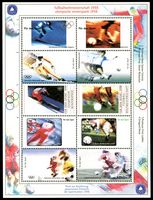Germany
ger-19980000-z-001
page = 1

Click here for higher resolution image
Occasion: 1998 Winter Olympics,1998,Nagano,Japan
Width: 116 mm
Height: 153 mm
Location: Ice Hockey Volume LII
Stamp ID = 5200
Proposed designs for the 1998 German stamps in honor of the 1998 Nagano Winter Olympics and the 1998 world cup of soccer. At the bottom of the page in German we have
Nicht zur Ausführung
gekommene Entwürfe
der Sportmarken 1998
gekommene Entwürfe
der Sportmarken 1998
translated
Not for execution
come designs
the sports brands 1998
come designs
the sports brands 1998
On the right hand side of the sheet we have listed 4 German graphic designers
From Linn's "Stamp Issuing Entities Of The World" page.
Germany (1872-)
Stamp-issuing status: active; Population: 84,068,216.State in central Europe. Traditionally divided into numerous petty sovereignties, German unification began with the growth of Prussian power in the 19th century. French occupation during the Napoleonic Wars brought the dissolution of many of the smaller states and stimulated German nationalism, which looked more and more to Prussia for leadership. The German Confederation (1815-66) and North German Confederation (1867-71) paved the way for unification. The Franco-Prussian War of 1870-71 brought the German states (except Austria) together to defeat France, and the German victory saw the creation of the German Empire with the Prussian king as emperor.. . .
In April 1945, soon after Hitler's suicide, Germany surrendered unconditionally. Germany lost all territory acquired after 1919, as well as much of that which had been left to it after its defeat in World War I. The country was divided into four zones of occupation, administered by the United States, Great Britain, France and the Soviet Union. In 1949, the German Federal Republic was formed from the three western zones, and the German Democratic Republic was created out of the Soviet zone.
. . .
With the fall of the East German communist regime in 1989, reunification proceeded rapidly, and by the end of 1990 the German Federal Republic and the German Democratic Republic had again become one nation.